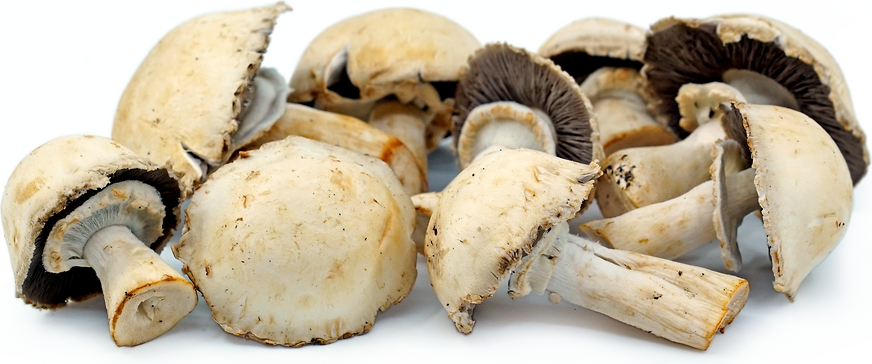


Horse Mushrooms
Estimated Inventory, lb : 0
Description/Taste
Horse mushrooms are medium to large in size, averaging 10-25 centimeters in diameter, and are rounded when young and flatten out when mature. The creamy white cap is smooth, firm, thick, and dry, and as it ages some light brown scales may appear in the center. Underneath the cap, the gills are free and crowded, first appearing light pink and then transforming into a dark brown, continuing to darken over time. When the mushroom is young, there is a distinct cogwheel pattern on the unopened veil, and as it matures, the veil runs down the stout stem and forms a small skirt. The stem can grow 4-10 centimeters in height and is thin becoming hollow with age. If bruised or exposed to air, the cap of the Horse mushroom may sometimes turn yellow. The smell of the Horse mushroom is said to be distinct, with a pungent anise or licorice aroma and when cooked, Horse mushrooms are succulent and crisp with a sweet, mild almond flavor.
Seasons/Availability
Horse mushrooms are available in the summer through fall, with limited availability in the spring in warmer climates.
Current Facts
Horse mushrooms, botanically classified as Agaricus arvensis, are wild edible mushrooms that belong to the Agaricaceae family. Also known as the Almond mushroom in Australia and the Snowball mushroom in New Zealand, Horse mushrooms are found growing alone or in rings in fields, pastures, or grassy areas in nutrient-rich soil. Pastures fertilized with horse manure is where the mushrooms likely got their name. Horse mushrooms are saprobic, meaning it grows and gets its nutrients from decayed organic material, versus a mycorrhizal fungus that has a symbiotic relationship with the roots of certain tree species. Horse mushrooms have recently declined in availability due to habitat loss, but they are still foraged and are cultivated on a very small scale in some areas. They are favored for their crisp texture and mild flavor.
Nutritional Value
Horse mushrooms contain high amounts of vitamin D. They also contain some iron, copper, zinc, and potassium.
Applications
Horse mushrooms are best suited for cooked applications such as sautéing, boiling, roasting, or grilling and can be used as an alternative to portobello mushrooms. Before cooking, wash the mushrooms under cool, running water, remove the stem and chop or slice the cap. Horse mushrooms can be sautéed and added to risotto, pasta, or egg dishes. They can also be used in soups, stews, sauces, or braising liquids for meat dishes. Horse mushrooms pair well with lemon juice, sweet cicely, wood sorrel, parmesan cheese, garlic, onions, parsley, meats such as beef or poultry, olives, and capers. They will keep up to a week when stored in a paper bag in the refrigerator.
Ethnic/Cultural Info
Horse mushrooms are a favorite variety to find among foragers for its large size and identifiable qualities including color and smell. There is a Horse mushroom look-a-like that is toxic known as the yellow stainer. When the stem of the yellow stainer is cut, as its name suggests, the exposed flesh turns bright yellow. This is not the case for the Horse mushroom, whose stem remains white when cut. If foraging, unless there is absolute certainty about a species of mushroom, it is recommended to not eat the mushroom until it has been approved by an expert. Horse mushrooms are predominately used for culinary purposes, but some claim that they are used in Chinese medicine for lower back and joint pain.
Geography/History
Horse mushrooms can be found growing throughout Europe and the United States, but they are most commonly found in Great Britain and Ireland. First described in 1762 by Jacob Christian Schaeffer in Bavaria, Schaeffer was a German botanist and mycologist who was one of the first to publish the descriptions of mushroom species never before formally recorded. Today Horse mushrooms are found in the wild, but they may also be available at local farmer’s markets and specialty stores in North America, Europe, Asia, Australia, and New Zealand.
Recipe Ideas
Recipes that include Horse Mushrooms. One
| First Time Foragers |
|
Baked Horse Mushroom Stuffed with Mushroomy Tapenade |
| The Hedgecombers |
|
Quick and Easy Creamy Mushroom Pasta |
| CKBK |
|
Horse Mushroom Croustade |
| Honest Food dot Net |
|
Provencal Mushrooms |
Podcast




